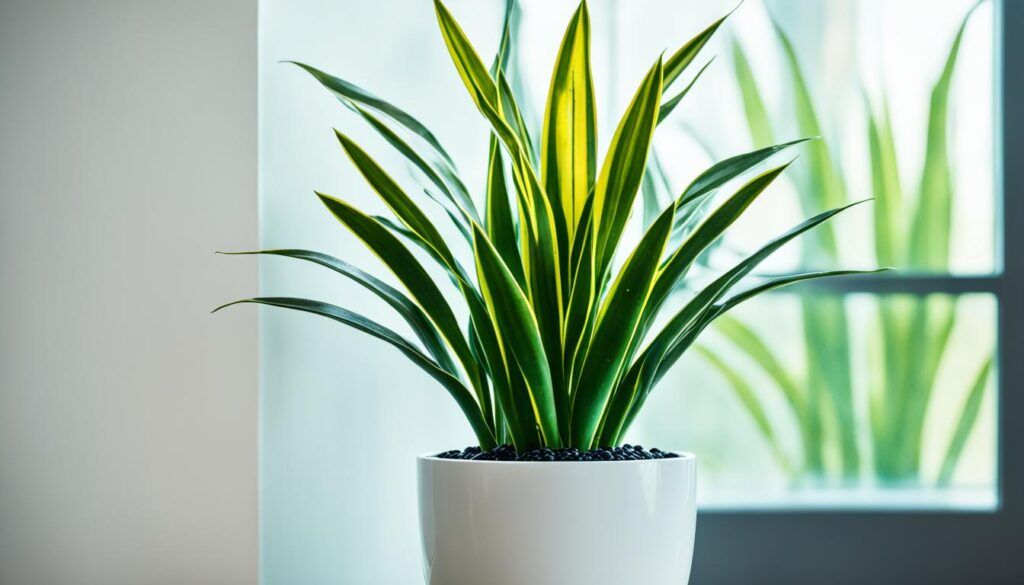Imagine walking into a room and seeing a beautiful, architectural plant with tall, green leaves. This is a snake plant. They are known for being tough and can grow well in many conditions. Caring for a snake plant indoors is easy and rewarding, whether you’re new to plants or not.
Key Takeaways
- Snake plants are known for being very low maintenance and almost impossible to kill.
- Watering is required fortnightly, or when the top two inches of soil feels dry.
- Snake plants can thrive in almost all light conditions, but prefer brighter places.
- Ideal temperature for snake plants is above 10°C, and they can survive at most temperatures.
- Snake plants don’t need much in terms of extra care, but wiping their leaves with a clean, damp cloth is beneficial.
What Is a Snake Plant?
Snake plants, also known as Sansevieria, come from western and southern Africa, and tropical places like Florida and Hawaii. They belong to the Asparagaceae family. These plants stand out with their upright leaves, which can be green or have cream, yellow, or white edges.
Native Habitat and Characteristics
Snake plants grow in dry areas of Africa where the light and humidity are low. They are versatile, easy-to-care-for plants. They can grow well in different lights, temperatures, and need little upkeep. This makes them perfect for indoor gardens because they clean the air and are easy to take care of.
Different Varieties of Snake Plants
There are many types of snake plants, each with its own look:
- The cylindrical Dracaena angolensis
- The compact Dracaena trifasciata ‘Hahnii’
- The variegated Dracaena trifasciata ‘Laurentii’
- The twisting Dracaena trifasciata ‘Twisted Sister’
“Sansevieria, also known as Mother-in-Law Tongue or Snake Plant, is scientifically named Dracaena Trifasciata.”
Why Are Snake Plants Easy to Care For?
Snake plants, also known as Sansevieria or Mother-in-Law’s Tongue, are known for being very easy to care for. They are perfect for busy people or beginners who want to add greenery indoors. These plants can grow well in many lighting conditions and can go without water for a while, earning them the nickname “unkillable” plants.
Snake plants are very resilient. They can grow well in many different environments. This makes them a great low maintenance houseplant choice. They can survive with little care and quickly recover from poor conditions, ideal for those with little time or plant care experience.
- Snake plants typically only need to be watered every 2-8 weeks, depending on the season and light conditions.
- They can thrive in a variety of lighting conditions, from bright indirect light to low-light environments, making them suitable for a range of indoor settings.
- Snake plants are known for their air-purifying abilities, helping to remove toxins and improve indoor air quality.
Snake plants can live up to 25 years with proper care, making them a long-term addition to your indoor garden. Their hardiness and low care needs make them perfect for adding greenery to your space without the trouble of high-maintenance plants.
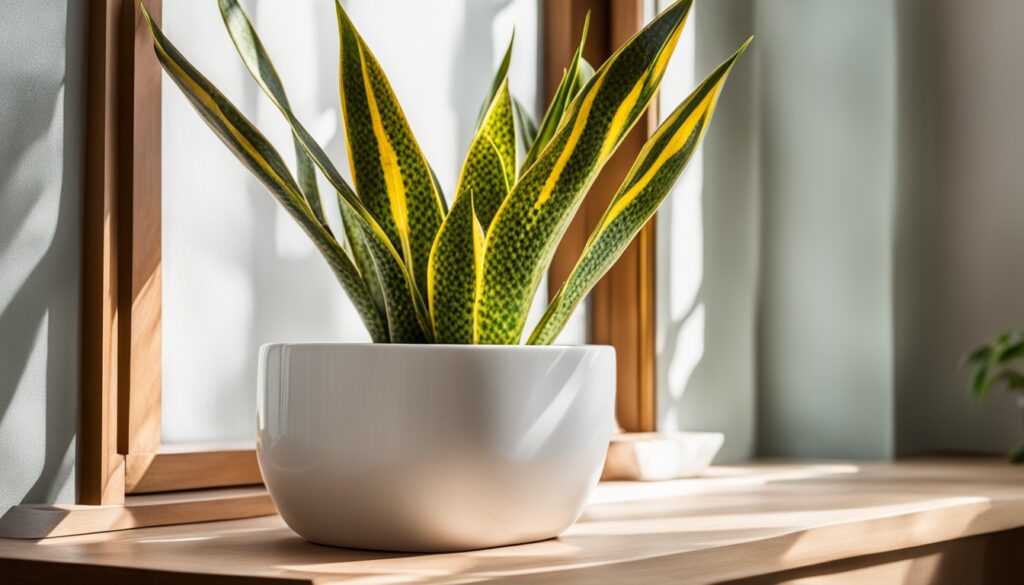
“Snake plants are the perfect choice for busy individuals or beginner plant owners looking to add a touch of greenery to their indoor spaces.”
The ease of care, resilience, and long life of snake plants make them a top choice among low maintenance houseplants. They are great for both experienced gardeners and beginners. These plants are easy to care for, bring nature indoors, and improve air quality with minimal effort.
Snake Plant Watering Requirements
Proper watering is key for your snake plant’s health and life span. These plants need just the right amount of water. Water them when the soil is dry, about every 2 weeks in the growing season and once a month in winter. Overwatering can quickly kill a snake by causing root rot.
Signs of Overwatering and Underwatering
Knowing the signs of over and underwatering is crucial. Overwatered plants turn yellow and have a soft, bad-smelling stem. Underwatered plants have dry, brittle leaves. Make sure to let the soil dry out fully before watering again to keep your plant healthy.
- Overwatering: Yellowing leaves, mushy and foul-smelling stem
- Underwatering: Brittle, dry leaves
Snake plants prefer dry environments and don’t need much humidity. Use rainwater, filtered water, or bottled water instead of tap water. Older snake plants can handle more water than younger ones.
https://www.youtube.com/watch?v=dcTuqj3F2Lo
“Proper watering practices include checking for signs of thirst such as dry and brittle leaves, inward curling leaves, and dry soil in the pot.”
By knowing how much water your snake plant needs and the signs of too much or too little water, you can keep it thriving for many years.
How to care for a snake plant indoors?
Caring for a snake plant indoors means giving it the right light, water, temperature, and soil. These plants love low light, making them great for indoor spaces. They do well under indirect sunlight from windows facing south or east.
Water your snake plant when the soil feels dry, usually every two weeks from March to November. In winter, water it once a month. Remember, don’t overwater as it can lead to root rot, a common problem.
Keep your snake plant in warm spots above 70°F and away from cold drafts. Use soil that drains well and is sandy. Repotting in spring helps with growth by giving the roots more space.
Keep your plant clean by dusting the leaves and fertilizing monthly when it’s growing. Prune dead or discolored leaves with sharp shears during the growing season.
With proper care, your snake plant can live for decades, adding beauty and ease to your home. These tips are great for both beginners and seasoned plant lovers. They ensure your snake plant stays healthy and vibrant.
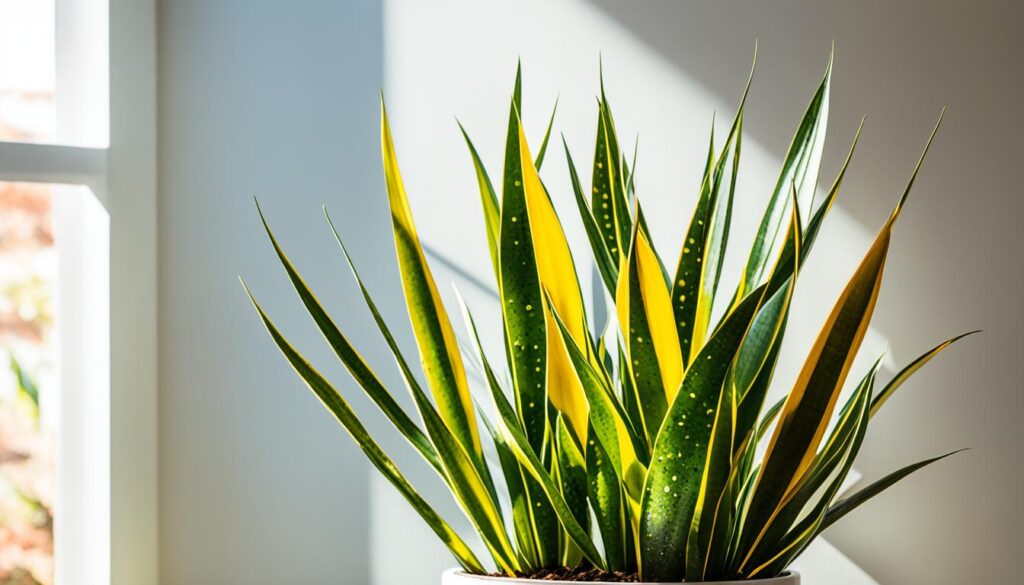
“Snake plants are one of the easiest houseplants to care for, making them suitable for beginners and experienced plant parents alike.”
Light Requirements for Indoor Snake Plants
Snake plants, known as Sansevieria or Dracaena trifasciata, are very flexible with light. They can grow well in bright sunlight or low light. For the best growth, they need 8-10 hours of indirect sunlight a day, near a window facing south or east.
Snake plants can live in low light but may grow slower and look less colorful. Too much direct sunlight can burn their leaves. It’s best to keep them in a spot with plenty of indirect, bright light.
If you don’t have much natural light, you can use artificial lights like LED, halogen, or fluorescent bulbs. Make sure these lights are close to the plant to give it enough light.
It’s important to watch how your snake plant is doing and move it or water it as needed. If it’s not getting enough light, it might look leggy or lose its color. Moving the plant to a brighter spot can help. With the right light, your snake plant will do well and make your home look nice.
“Snake plants are a great choice for indoor environments because they are so adaptable to different light conditions.”
In summary, snake plants are very good at handling different light levels. They like bright, indirect sunlight but can also do well in low light. By knowing what light they need and moving them around, you can keep your indoor snake plant healthy and looking good.
Ideal Temperature for Snake Plants
Temperature is key for growing healthy snake plants indoors. These plants like warm and steady temperatures, between 70-90°F (21-32°C). They can handle humidity levels of 30-50%, making them perfect for indoor growth.
But, don’t let them get too cold. Temperatures under 50°F (10°C) can hurt or kill them. Keep them away from cold drafts and frost areas. The bathroom might be too humid for them, as they like it drier.
For the best spot, try the bedroom or living room. These places usually stay warm and steady. Giving your snake plant the ideal temperature for its growth helps it thrive and brightens your space.
“Snake plants can tolerate temperatures between 65 and 90 degrees Fahrenheit, making them a versatile choice for indoor gardening.”
Snake plants also need the right snake plant care temperature for optimal growth indoors. Knowing their temperature needs helps you create the best home for them. This way, your snake plant can grow well and add beauty to your home.

Repotting Snake Plants
Snake plants, also known as Sansevieria, are known for being tough and easy to care for. But, they still need repotting every now and then to do well. So, when should you repot a snake plant, and how do you do it?
When to Repot
Snake plants should be moved to a new pot every 3 to 5 years, or when their roots fill the container. Look out for these signs that it’s time to repot:
- Water draining out too quickly
- Roots visible at the surface
- Stunted growth
The best time to repot a snake plant is in the spring, when it’s growing the most.
Repotting Steps
When you’re repotting a snake plant, pick a pot that’s 2 inches wider than the old one and has good drainage holes. Carefully take the plant out of its old pot, loosen any tangled roots, and put it in fresh potting mix made for cacti and succulents. Make sure to plant the snake plant at the same level as before to avoid covering the stem.
“Snake plants are almost indestructible indoor plants that thrive with minimal care.”
By following these easy steps, you can keep your snake plant healthy and happy for many years.
Fertilizing Snake Plants
Keeping your indoor snake plant well-nourished is key to its health and looks. These tough plants do well with a bit of food during their growing season, from March to November.
A good choice for fertilizing snake plants is a balanced 10-10-10 fertilizer. Mix it with water at half strength. Feed your plant with this once a month to keep it healthy.
- Avoid over-fertilizing, as this can lead to leggy growth and leaf discoloration.
- During the winter months, you can skip fertilizing altogether, as the plant goes into a resting period.
Learning how to fertilize snake plants right is important for their health. A balanced feeding schedule can make your snake plant grow strong and might even bloom beautifully.
“Fertilizing your snake plant can help with its growth and potentially increase the chances of blooming.”

Remember, don’t overdo it when fertilizing snake plants. Follow the recommended mix and schedule to keep your plant happy and healthy.
Pruning and Cleaning Snake Plant Leaves
To keep your indoor snake plant looking great, you need to prune and clean its leaves. Prune during spring and summer when it grows. Use sharp pruners to cut dead, damaged, or discolored leaves at the base. Cutting tall leaves also helps control the plant’s size, making it perfect for indoor spaces.
Experts say prune snake plants every 1-2 years because they’re easy to care for. They can grow up to 12 feet tall but stay shorter indoors with pruning. Pruning also helps you make new plants by rooting cut sections in water or soil.
Don’t forget to dust the leaves with a damp cloth to remove dust and debris. This keeps the plant healthy and helps it absorb light better. Keeping the leaves clean also keeps your plant looking its best.
“Proper grooming and leaf cleaning will help maintain the vibrant appearance of your indoor snake plant.”
Follow these pruning and cleaning tips to keep your snake plant healthy and beautiful. These simple steps are key for snake plant maintenance and help your plant flourish.
https://www.youtube.com/watch?v=cCFGSVOnchA
Snake Plant Propagation
Snake plants, also known as Sansevieria, are tough and easy to grow houseplants. You can make more plants from one you already have, using division or leaf cuttings. Learning how to propagate snake plants is rewarding. It lets you watch new plants grow and flourish.
Propagating by Division
Dividing is a simple way to make more snake plants. You need to split the plant’s rhizome, which is the underground stem. Each piece should have roots and leaves to grow well. To do this, take the plant out of its pot and cut the rhizome with a sharp knife.
Put the cut pieces in fresh potting soil and water them a little. This method is easy and effective.
Propagating from Leaf Cuttings
You can also use leaf cuttings to grow new snake plants. Pick a healthy leaf and cut it near the soil with a sharp tool. Let the cut leaf dry out for a few days before planting it in soil or water.
New plants will grow from the leaf base. This is a great way to spread these easy-care plants.
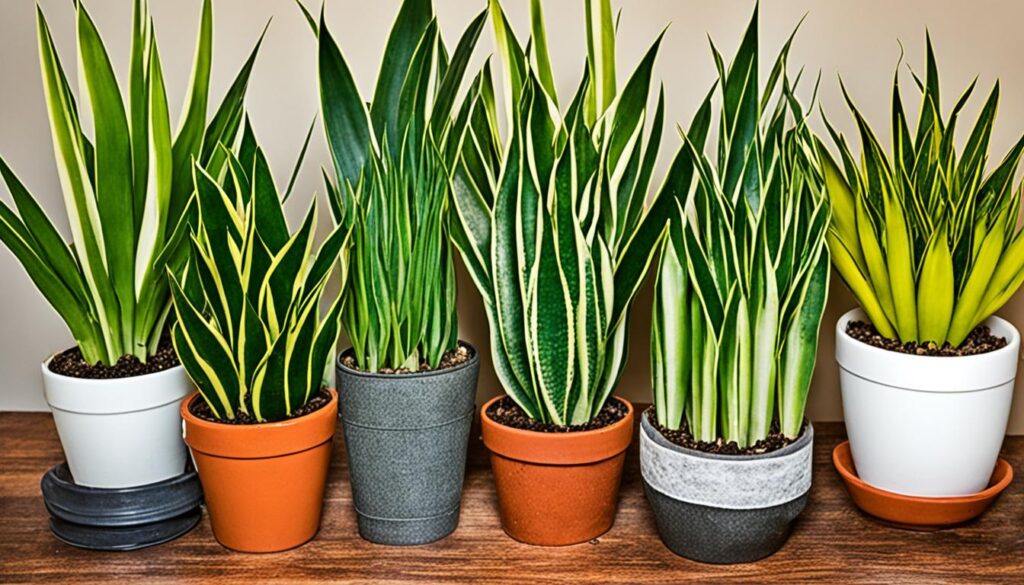
Remember, the best time to propagate snake plants is in spring and summer. They grow and develop roots well during these months. With proper care, your new plants will quickly grow and add to your indoor garden.
Common Snake Plant Problems
Snake plants are easy to care for and tough, but they can face pests, diseases, or other issues. Knowing about these problems and how to fix them can help your snake plant stay healthy.
Pests and Diseases
Common pests include aphids, mealybugs, spider mites, and scale insects. These pests can be controlled with insecticidal soap or neem oil.
Overwatering is the main cause of disease in snake plants, leading to root rot and fungal infections. Look out for foul smells, mushy stems, and yellow leaves.
Troubleshooting Leaf Issues
- Curling, drooping, or discolored leaves suggest problems with watering, light, or soil conditions.
- Overwatering makes leaves turn yellow and droop. Underwatering causes them to curl or wilt.
- Too much direct sunlight can scorch leaves, making them brown at the tips or edges.
Quickly spotting and fixing these leaf issues is key to keeping your snake plant healthy. Regular checks and adjusting your care can prevent and solve many common problems.
https://www.youtube.com/watch?v=FnShxIKP98c
Benefits of Having a Snake Plant Indoors
Adding a snake plant to your home can bring many benefits. These plants are easy to care for and can thrive in busy homes or for those new to gardening. They add beauty with their unique leaves and can make any room look better.
One big plus of having a snake plant is its ability to clean the air. They take in harmful substances like formaldehyde and benzene and give out oxygen, especially when you’re sleeping. Having one plant in every 100 square feet can make the air much cleaner.
Snake plants also have health benefits. They can lessen headaches, eye problems, and breathing issues. They might even help you focus better and be more productive. In feng shui, they’re seen as lucky plants that bring positive energy into a space.
“Snake plants are recognized for filtering indoor air, and they are one of the few plants that can convert carbon dioxide (CO2) into oxygen at night, making them ideal for bedroom decor.”
Snake plants look great in any room. They fit well in many lighting conditions and can brighten up your living room, bedroom, or office. Adding one can really make your space look better.
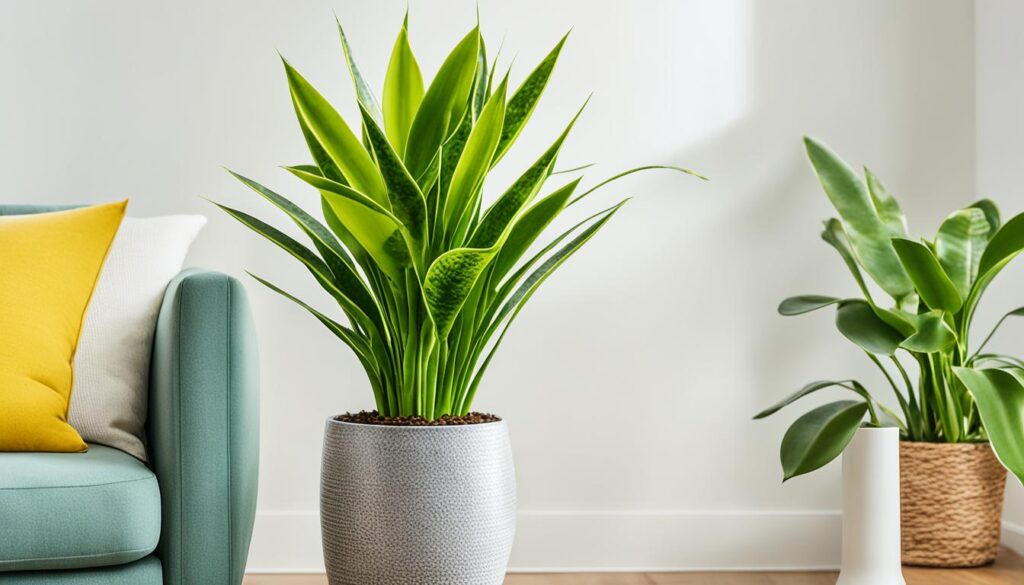
In summary, snake plants offer many benefits indoors. They purify the air, can be good for your health, and are easy to care for. Adding a snake plant to your home means enjoying these perks while making your space healthier and more lively.
Conclusion
Caring for snake plants indoors is easy and rewarding. These plants are known for thriving with little effort. They’re perfect for anyone who loves plants, no matter their experience level.
By giving them the right amount of light, water, temperature, and nutrients, your snake plant will stay healthy and beautiful. This makes them a great addition to your home or office for many years.
This guide has given you all the tips you need to grow and keep snake plants happy. It covers everything from how to start them to fixing common problems. You’re now ready to care for your snake plants like a pro.
Snake plants are great because they clean the air, need little care, and fit into any space. With the advice from this guide, you can make the most of these amazing plants. Enjoy their beauty, benefits, and how they improve your indoor space.
